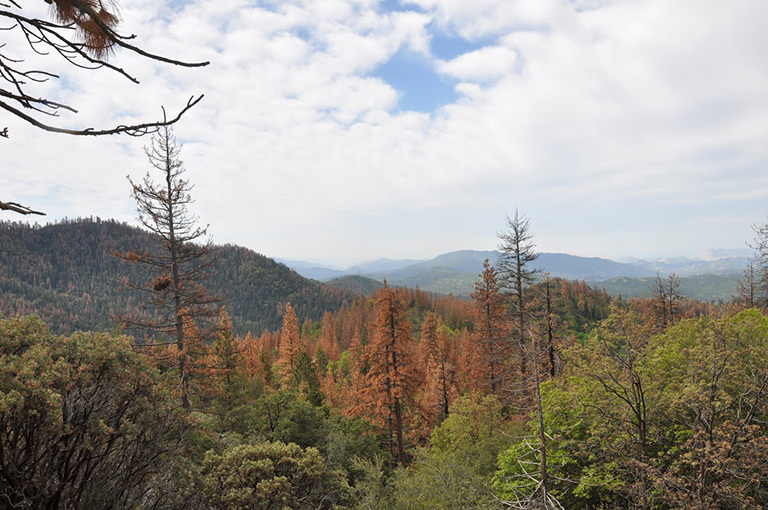
NASA maps California drought effects on Sierra trees. (Photo: climate.nasa.gov)
Long-Term Solutions for California Wildfire Prevention
California’s wildfires, and the two very different responses they generate, are emblematic of the entire climate change debate
By Edward Ring, November 7, 2019 2:05 am
Nobody knew how the fire started. It took hold in the dry chaparral and grasslands and quickly spread up the sides of the canyon. Propelled by winds gusting over 40 miles per hour and extremely dry air (humidity below 25 percent), the fire spread over the ridge and into the town below. Overwhelmed firefighters could not contain the blaze as it swept through the streets, immolating homes by the hundreds. Even brick homes with slate roofs were not spared. Before it finally was brought under control, 640 structures including 584 homes had been reduced to ashes. Over 4,000 people were left homeless.
Does this sound like the “new normal?” Maybe so, but this description is of the Berkeley fire of 1923. In its time, with barely 4 million people living in California, the Berkeley fire was a catastrophe on par with the fires we see today.
When evaluating what happened in nearly a century since this fire, two stories emerge. The story coming from California’s politicians emphasizes climate change. From former Governor Jerry Brown: “In less than five years, even the worst skeptics will be believers.” From current Governor Gavin Newsom, speaking on the threat of wildfires in the state: “If anyone is wondering if climate change is real, come to California.”
The other story, which comes from professional foresters, emphasizes how different forest management practices might have made many of the recent fires far less severe, if not avoided entirely. Specifically, California’s misguided forest management practices included several decades of successful fire suppression, combined with a failure to remove all the undergrowth that results when natural fires aren’t allowed to burn.
Back in 1923, forest fire suppression was in its infancy. But techniques and technologies improved apace with firefighting budgets, until by the second half of the 20th century, an army of firefighters coped, overall, very effectively with California’s wildfires. The result is excessive undergrowth which not only creates fuel for catastrophic and unmanageable super fires, but these excessive trees and shrubs compete with mature trees. This is the real reason why California’s forests are not only tinderboxes, but also filled with dying trees. Now Californians confront nearly 20 million acres of overgrown forests. Behind the climate change rhetoric and political posturing, a consensus has quietly formed that California’s forests need to be thinned.
In order to rapidly address the challenge of thinning California’s forests, there are several steps that may be taken simultaneously. For starters, many environmental regulations need to be rewritten. The state is already beginning to grant CEQA exemptions to property owners that want to engage in thinning operations. But half of California’s forests are on federal land. At the federal level, the EPA’s “no action” restrictions, usually based on the “single species management” practice, have led to more than half of California’s national forests being off limits to tree thinning, brush removal, or any other sort of active management.
Another required change is the U.S. Forest Service guidelines which only permit active forest management, even in the areas that are not off limits, for as little as six weeks per year. While restrictions on when and where forests can be thinned may have sound ecological justifications in some ways, they are making it impossible to thin the forests. The ecological cost/benefits need to be reassessed. To be effective, thinning operations need to be allowed to run for several months each year, instead of several weeks each year.
The EPA needs to streamline the NEPA (National Environmental Policy Act) application process so it is less expensive and time consuming for qualified companies to get permits to extract timber from federal lands. They can also grant waivers to allow thinning projects to bypass NEPA, or at the least, broaden the allowable exemptions.
The federal government can accelerate granting of long term stewardship contracts whereby qualified companies acquire a minimum 20 year right to extract wood products from federal lands. This will guarantee a steady supply of wood products which, in turn, will make new investment viable in logging equipment, mills, and biomass energy facilities.
Rules and conditions governing timber exports need revision. The export of raw logs from federal lands in the Western United States is currently prohibited. Lifting this prohibition would help, because sawmill capacity is not capable of handling the increase in volume. Just with the new thinning programs already in place, logs and undergrowth are being burned or put in landfills.
As it is, California imports around 80 percent of the cut lumber used in its construction industry or sold through retailers to consumers. If there was an assurance of wood supply, which the national forests can certainly offer, investment would be made in expanding mill capacity. Suddenly the money that is being sent to Oregon, Washington and British Colombia to purchase their cut timber would stay here in California, employing thousands of workers in the mills.
The state or federal government can set up revolving loan funds for investors to build sawmills, as well as biomass energy facilities, as well as chippers and other equipment, that would allow the industry to quickly ramp up operations and capacity.
As California’s forests are thinned, and kept that way, and the annual supply of wood is permanently increased, in-state demand would become increasingly unable to absorb in-state supply, and the surplus could be exported, earning additional profits and supporting additional jobs. Biomass plants, burning carbon neutral wood chips, could profitably generate safe, affordable, distributed electricity to rural markets, employing additional thousands and delivering returns to private investors.
Finally, California has an opportunity to rehabilitate able-bodied homeless substance abusers by putting them to work thinning the forests. With only modest reforms to California’s criminal code, or perhaps via a state or federal state of emergency, homeless people convicted of drug or minor property crimes could serve their time working on labor crews thinning the forests.
Cal Fire, the California Dept. of Corrections, and the California Conservation Corps are all equipped to train and house people to do this work. It might be the best thing that ever happened to thousands of young homeless Californians who, once they are freed from substance abuse, are sane, able bodied people. Thousands might recover their dignity and their future in this manner, at the same time as they help restore health to California’s forests.
The Right and Wrong Responses to California Wildfires
Many of the recommendations here are already in progress. Others should be considered. To make them happen more quickly and effectively, California’s state officials should be working with the Trump administration behind the scenes, even if they savage each other in the public square. But there are other steps California’s policymakers are taking which are harmful to working Californians.
For example, there is the growing conventional wisdom that people should not be living in the “Urban Wildland Interface” (UWI). While common sense indicates people living in the UWI cannot have the same expectations regarding fire risk as people living in the urban core, it would be a tragic mistake to deny people the ability to escape urban areas and find affordable options in rural areas.
California’s insurance commissioner, Ricardo Lara, could with a stroke of his pen, allow private insurance companies to pass on the escalating costs of reinsurance for fire prone areas to the customers who live in those areas. Because they can’t do that, private insurers are cancelling policies. California’s state run insurance which remains available to people in fire prone areas is far more expensive, which is driving people out of their homes.
There are three layers of protection against fires for people living in the UWI. The first, forest thinning, needs to involve multiple agencies cooperating based on community needs and land topography, rather than stopping at arbitrary jurisdictional boundaries. The second layer of protection requires removing combustible material along access roads, ensuring safe evacuation routes. Roads need to be wide enough to allow cars to evacuate one way at the same time as oncoming firefighting vehicles pass in the other direction. Third, homes themselves need to be hardened against embers, with brush and other combustible materials cleared away from the structures. With these conditions met, insurance against fires can be affordable, even if it still costs more than fire insurance outside of the UWI.
The threat of wildfires is not only being used to amplify panic over climate change, it is being used to justify and accelerate policies designed to combat climate change. Many of these policies are misguided and extreme. The example of prohibiting new construction in rural areas based on the wildfire threat is one of them. Another is the fast tracking of legislation aimed at achieving the 2030 targets for California’s aggregate greenhouse gas emissions.
One of the latest bits of pending legislation pursuant to California hitting its 2030 greenhouse gas emissions target is the intention to charge automobile owners based in their “vehicle miles traveled.” If one reflects on who will be impacted by a law of this sort, it is revealed as one of the most misanthropic, regressive laws ever proposed in California. The people who live on the outskirts of cities and have super-commutes, the people who are gone from 7 a.m. till 8 p.m. every day so they can keep their family under a roof, will now have to pay extra for the privilege of enduring that super-commute.
The equally misanthropic alternative that California’s climate activist legislators propose is to construct high density condominiums and apartments located by light rail stations and bus stops. These residences will have their parking requirements waived. Imagine, if you will, a parent of three, still barely able to pay rent, living without a car in one of these “transit villages.” Without a car, exactly how will they pick up their children from school, deposit them at soccer practice, do the dinner shopping, go home and drop off groceries, then pick them up from soccer practice, all while riding various buses? It’s impossible.
Ultimately, perhaps California’s wildfires, and the two very different responses they generate, are emblematic of the entire climate change debate. On one side you have the righteous climate activists, determined to save the planet at all costs. On the other you have working practitioners with expertise earned in the real world, with empathy for real people.
How will we look back at this era? How will history judge our responses to the challenges of our time, in 2123?
- Ringside: What is the Future of California’s Republican Party? - December 31, 2025
- Ringside: CA GOP Just Blew $46 Million for Nothing – Here’s How They Can Avoid Repeating That Mistake in 2026 - December 24, 2025
- Ringside: Will the Delta Pumps Operate at Capacity this Winter? - December 18, 2025





Excellent article. But get real. None of this is ever going to happen. Makes Way too much sense. This is California after all!